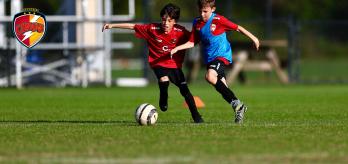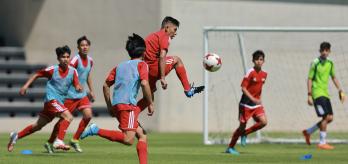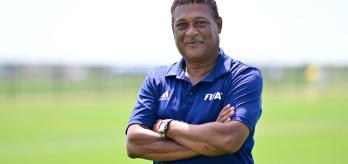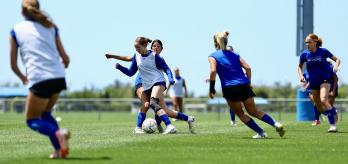By focusing on ball skills, such as having a good first touch, setting up a 1v1 take-on, and taking a touch to move into space, players can deal with pressure more effectively and successfully evade opponents.
In this session, Clearwater Chargers head coach Juan de Brigard delivers a set of exercises focusing on a player’s ball control and ability in 1v1 situations. The session starts with a warm-up where players practise various ball-control actions while moving around a reduced playing area. This is followed by a small-sided game involving 1v1 and 2v1 scenarios. Finally, the session ends with a 6v6 small-sided game where they can practise their 1v1 abilities from isolated areas on the pitch.
This session is centered around three core principles: technique, the use of small-sided games, and a progressive structure. Players will focus on developing their technical skills through targeted exercises, while small-sided games will be used to encourage more touches on the ball and decision-making in realistic scenarios. The session is designed to be progressive, gradually increasing in complexity and intensity to ensure continuous development and engagement.
Part 1: Dynamic warm-up
The session begins with a dynamic warm-up that offers players various exercises centred on ball control and juggling skills. The warm-up prepares players for multiple situations in which they must receive the ball and bring it under control.
-
Mark out a 30x40m area.
-
Position 12 players inside the area.
-
Provide one ball per player.
-
The players must dribble with the ball freely inside the 30x40m area.
-
The players must avoid running into one another.
-
They must pass the ball about 10 metres in front of them and then run onto it.
-
The players sit down and must juggle the ball through some keepy-ups.
-
The players should kick the ball into the air, let it bounce, and then kick it high into the air again, moving around while doing it.
-
Players must kick the ball into the air and then control it with the thigh. Once they control the ball with the thigh, they must touch it again so that it is on the ground and then move into space with it.
-
The players must bounce the ball first and then control it, taking a touch into space.
-
Next, the players kick the ball into the air, let it bounce, and kick it higher than previously. They must control the ball on the bounce into space.
-
Show good awareness and anticipation by seeing where space opens up and moving the ball in that direction with the initial touch.
-
Practise different techniques of controlling the ball so that it is easier to manage it in all scenarios.
-
Avoid running into traffic by making a clean first touch away from the other players.
Part 2: 1v1 and 2v1 small-sided game
This second exercise introduces 1v1 and 2v1 situations in which players must focus on 1v1 attacking and defending skills, including ball control, dribbling, vision and tackling.
-
Mark out a 30x40m area.
-
Position 2 mini-goals at either end.
-
Position an attacker and a defender in each half.
-
In the first half, the attacker starts between the 2 mini-goals.
-
The defender is positioned close to the halfway line.
-
The remaining players wait behind the goals.
-
The coach passes the ball to the attacking player between the mini-goals.
-
As soon as the ball is played, the defender in this half must press the attacker.
-
The attacker has to engage the defender and beat him with the ball.
-
Once the attacker passes the halfway line, the first defender should stop.
-
The second defender then becomes active, as well as the other attacker, to initiate a 2v1 scenario.
-
The 2 attackers must link up and try to score.
-
If the defender wins the ball, he must pass to his team-mate and try to score in the opposite mini-goals.
-
The game stops if they fail to do so.
-
A good first touch helps players to remain in control of the situation and build momentum when approaching the defender.
-
Close control and an upright posture help the player to arrive in the opposite half with a good advantage.
-
As soon as the attacker gains an advantage over the first defender, they should pay attention to where their team-mate and other defenders are, allowing them to make better decisions.
-
Defenders must engage the attackers immediately and apply pressure to make it more difficult for them.
Part 3: 6v6 small-sided game
This final small-sided game reinforces the 1v1 skills that players have taken on board and puts them in game-like scenarios.
-
Mark out a 50x30m area.
-
Outline a 5m channel on each side of the pitch.
-
Position 2 mini-goals at both ends of the pitch.
-
Split the group into 2 teams of 6.
-
The ball starts with the coach.
-
A player from the receiving team must wait in one of the channels close to their goal.
-
They must try to take on the first defender inside the channel once they receive the ball.
-
Once they beat the defender, the game continues as normal, and the attacking team has to try to score in either one of the mini-goals.
-
The defending team must try to score in the opposite mini-goals if they win the ball.
-
The game always restarts with a 1v1 in the isolated areas.
-
Being on the front foot and having a good first touch are required for players to set up a successful 1v1 take-on.
-
After completing a take-on, players must be aware of the positioning of their team-mates and opposing defenders to take advantage of the situation.
-
Encourage attackers to put defenders off balance by using feints, shimmies and tricks.




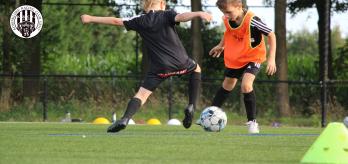
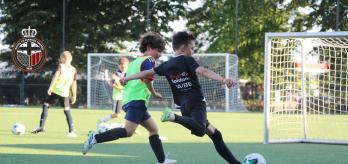
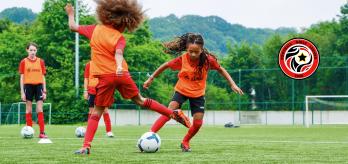
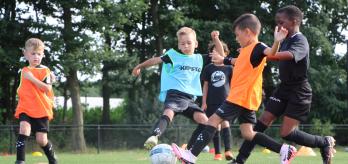

.variant64x64.jpg)

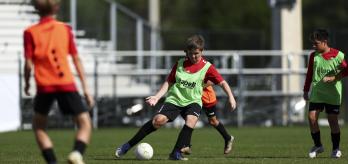
.variant348x164.jpg)
